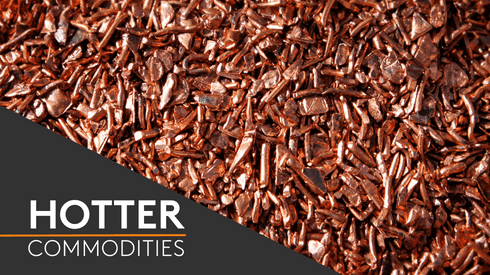As Bart Chilton, outgoing commissioner of the US Commodity Futures Trading Commission, said this week: “at last.”
After months of wrangling, the US regulator has approved new regulation on position limits for commodities derivatives.
The rules, part of the 2010 Dodd-Frank Wall Street Reform and Consumer Protection Act, establish position limits in 28 commodities in agricultural, energy and metals markets as part of a phased approach.
It establishes one-position-limits regime for the spot month and another for single-month and all-months-combined limits, known as non-spot-month position limits.
The limits apply to five metals – Comex copper, gold and silver, as well as Nymex platinum and palladium – and for non-spot-month positions will be set at 10 percent of open interest in the first 25,000 contracts and 2.5 percent thereafter.
How it works
While the CFTC currently only imposes limits on nine agricultural commodities contracts, the CME sets its own accountability limits for all of its derivatives contracts.
Those limits are not set in stone; the CME assesses whether or not a participant hitting the upper edge of those limits is a bona fide hedger, or whether it needs to start to reduce it net position.
Clearly the CME supports the idea of position limits; however, it’s not a fan of the new rules.
“We do not believe the proposed rules, which require that federal position limits be set and implemented by the CFTC, are warranted or necessary, particularly outside of the spot months,” the CME said in a statement.
“If implemented, these proposed rules could prevent people from hedging in the first place, or create the unintended consequence of pushing participants out of the best-regulated markets, into less-regulated markets that carry greater risk,” it added.
For copper, it’s not enormously drastic, but it does reduce the level of positions a participant can have.
Take 100,000 contracts of Comex copper as an example.
Based on the new CFTC limit, 10 percent of the contract’s first 25,000 of open interest would be 2,500 contracts, plus 1,875 contracts based on 2.5 percent of the remaining 75,000 contracts.
That makes a total open position limit of 4,375 contracts, equivalent to just over 54,000 short tons and roughly 49,000 tonnes.
Under CME rules, single month and all-month position limits are currently 5,000 contracts each.
The CFTC has used historical data to estimate that no more than 16 traders in any metal referenced contract would hold or control positions that would exceed either a single month or all months combined limit.
Background
The process to impose the limits has been lengthy; the hearing this week was the ninth public meeting of its kind since CFTC chairman Gary Gensler took over in May 2009.
As Gensler told a hearing to debate the proposals in Washington this week, position limits have been a tool to curb or prevent excessive speculation that may burden interstate commerce since they were introduced by the Commodity Exchange Act in 1936.
In the Dodd-Frank Act, Congress directed the CFTC to impose limits on speculative positions in physical commodity futures and options contracts and economically equivalent swaps.
Just over two years ago, the CFTC finalised a rule that would prevent any single trader from obtaining too large a share of the market, in order to ensure that derivatives markets remain fair and competitive.
But in September 2012, a federal court threw the rule out, stalling the imposition of the new proposed limits.
Speculation and prices
The link between the influence on prices of speculative trading activity has long been debated, particularly since commodity prices soared and drove the cost of food, oil and raw materials like copper to record highs.
Hannah Ropp, Office of Chief Economist at the CFTC, told the meeting in Washington that her office had conducted 130 studies into the relationship between speculation and price, with no overall conclusion.
“We’ve got about a third of [the studies] that say excessive speculation has an impact, about a third that say it doesn’t, and about a third that says they can’t tell,” she said.
That was enough for the CFTC’s Gensler, who said he would prefer to “err on the side of caution than to kind of ignore the at least one third that say there could be a real problem here.”
It’s a debate that is also being held at the G20 meetings, with the issue first attracting attention due to high food and energy prices.
LME
It’s a debate no doubt being closely eyed at the London Metal Exchange, which has no position limits on its derivatives trading and has in the past said it sees no merit in introducing them.
The LME already has its own form of position limits in its lending guidance, the exchange’s response to the effect of dominant positions in the market.
It doesn’t stop members building positions.
Opponents to the idea of position limits say that there is speculative activity in all aspects of the markets, including the decision of producers and consumers to hedge or remove hedges, hedge funds’ decisions to engage in spread trading, and merchants’ strategies to hedge inventories.
They also say that unless the playing field is internationally level, position limits are worthless because of the substantial market liquidity for commodities outside of the USA. In the case of copper, for instance, the primary benchmark is clearly the LME price.
But with the LME already gearing to consider introducing a Commitments of Traders report showing the breakdown of open interest in its markets, the debate over position limits is likely to be back on the future agenda too.
Regulatory pressure is also being brought to bear in the form of European Markets Infrastructure Regulation (EMIR) and the Markets in Financial Instruments Directive (MiFID).
The LME will need to ensure that any position limits European regulators might impose in the future are nuanced to take account of the various markets they are dealing with.
Andrea Hotter
http://www.metalbulletin.com/Hotter-on-Metals.html
ahotter@metalbulletin.com
Twitter: @andreahotter




